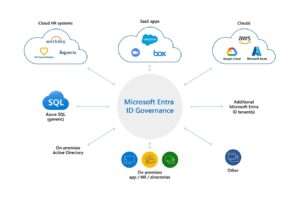The future of work is here, and Microsoft is leading the charge with groundbreaking enhancements to its Windows 365 Cloud PC platform. As businesses worldwide seek resilient, secure, and cost-effective IT solutions, Microsoft has unveiled a suite of new features designed to streamline operations, boost productivity, and maximize return on investment.
Among the latest advancements is Windows 365 Link, the first purpose-built Cloud PC device, alongside expanded access through Windows 365 Frontline’s shared mode, enhanced disaster recovery capabilities, and seamless cross-platform integration via the Windows App. These innovations are not just theoretical upgrades—they come with hard numbers. A Forrester Consulting study commissioned by Microsoft projects a staggering 94% to 217% ROI for organizations adopting Windows 365 and Azure Virtual Desktop, reinforcing the financial and operational benefits of cloud-based computing.
The Economic Case for Cloud PCs: Forrester’s ROI Findings
The 2025 Total Economic Impact™ study by Forrester Consulting paints a compelling picture of the advantages businesses can expect from migrating to Windows 365 and Azure Virtual Desktop. For a composite organization with 2,000 employees, the projected net present value (NPV) ranges between 3.2millionand7.4 million over three years. Key takeaways from the research include:
- Enhanced Productivity: Employees save 6 to 12 minutes per day thanks to reduced outages and improved system responsiveness.
- Cost Savings: Companies implementing bring-your-own-PC (BYOPC) programs avoid purchasing and maintaining physical laptops, saving 1.1to1.2 million over three years.
- Reduced IT Overhead: Migrating to cloud-based PCs cuts on-premises infrastructure costs by 722,000to1.5 million.
- Stronger Security: Microsoft-managed services reduce the need for in-house security infrastructure, leading to 60,000to122,000 in savings.
These findings underscore a clear trend: businesses leveraging cloud PCs are not just modernizing—they’re driving measurable efficiency and profitability.
Windows 365 Link: The First Dedicated Cloud PC Device
One of the most exciting announcements is the general availability of Windows 365 Link, a compact, purpose-built device that connects users to their Cloud PC in seconds. Unlike traditional PCs, these devices require minimal setup, integrate seamlessly with Microsoft Intune for IT management, and leave no local data traces after logout—making them ideal for shared workspaces.
Priced at $349.99 in the U.S. (with regional variations), Windows 365 Link is already making waves in industries like manufacturing, where quick access to cloud resources is critical. Krones, a global packaging and bottling company, has adopted the devices to streamline shop-floor operations.
“We needed a purpose-built device for our collaborative workflows,” said Roman Kleyn, Head of Workplace Design at Krones. “Windows 365 Link was the perfect solution.”
The device is now available through select resellers worldwide, including SHI International Corp. in the U.S., Bechtle AG in Germany, and ASI Solutions in Australia.

Windows 365 Frontline: Shared Mode for Flexible Workforce Access
For organizations with rotating or part-time staff, Microsoft has introduced shared mode for Windows 365 Frontline. This feature allows multiple users to access a single Cloud PC license on a rotating basis, optimizing costs while maintaining security.
- How It Works: One license covers one active session at a time, with profiles automatically wiped after logout.
- Use Cases: Ideal for inventory clerks, seasonal workers, or contractors who need temporary access to corporate apps.
- Customer Impact: Belgian IT firm Arxus reported faster project delivery and eliminated VPN complexities by using shared Cloud PCs for external collaborators.
Additionally, Windows Autopilot device preparation (now in public preview) simplifies image management, allowing IT teams to pre-install essential apps and scripts during provisioning.
Disaster Recovery Plus: Minimizing Downtime in Regional Outages
Business continuity is a top priority, and Microsoft’s Windows 365 Disaster Recovery Plus (now generally available) ensures rapid recovery in emergencies. Key features include:
- 60-minute Recovery Point Objective (RPO)
- 30-minute Recovery Time Objective (RTO)*
- Cross-region replication for compliance resilience
(*Performance goals, not guarantees)
This service is particularly valuable for industries like finance and healthcare, where prolonged downtime is unacceptable.
Simplified Migration and Expanded Cross-Platform Access
To ease the transition to Cloud PCs, Microsoft is rolling out a Windows 365 Migration API, enabling businesses to convert existing virtual machines into Cloud PCs seamlessly.
Meanwhile, the Windows App—now available on Android—completes Microsoft’s cross-platform strategy, offering a unified portal for Windows 365, Azure Virtual Desktop, and Remote Desktop Services.
- New Features: Passkey authentication, Government Cloud support, and upcoming Teams optimization for mobile.
- Zebra Technologies Integration: Workers using Zebra mobile devices can now access full Windows desktops on the go.
Enhanced Security: Hotpatch Updates and MAM Protections
Security remains a cornerstone of Microsoft’s cloud strategy. New advancements include:
- Hotpatch Updates for Windows 11 Enterprise: Eliminates reboot requirements for critical patches.
- Mobile Application Management (MAM) for Windows App on Android: Ensures corporate data protection on personal devices.
With these innovations, Microsoft is not just adapting to the future of work—it’s defining it. From frontline workers to remote developers, Windows 365 is breaking down barriers, reducing costs, and empowering businesses to thrive in a cloud-first world.
For IT leaders, the message is clear: The time to transition is now. The financial benefits are proven, the tools are ready, and the workforce is waiting.
To explore the full Forrester study or dive deeper into Windows 365’s capabilities, visit aka.ms/WCTEI2025info.
















Add Comment